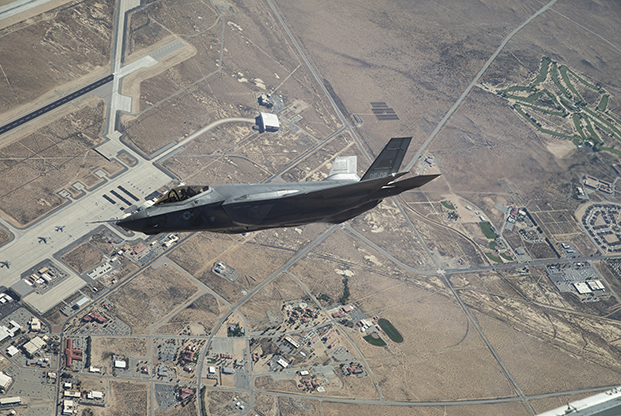
An F-35A assigned to the 461st Flight Test Squadron flies over Edwards Air Force Base on Sept. 15. Lockheed Martin photo by Chad Bellay via DOD.?
The F-35 production line, although meeting annual targets, is late on monthly deliveries, and the Joint Program Office has put Lockheed Martin on notice that it must step up quality or lose some incentive fees. Program Executive Officer Vice Adm. Mat Winter also said the military services have decided to upgrade all their existing jets to the Block 3 standard, but have not yet decided if they will eventually mod all their jets to a Block 4 configuration.
“We are seeing increased touch labor and rework,” Winter told reporters at a twice-annual F-35 status report briefing in Arlington, Va. The line is “not hitting … monthly deliverables,” he said. The problem stems from “repair, rework, and scrap” of parts on the assembly line that are, for various reasons, not right. Although individually these quality escapes are not adding huge costs, Winter said, each one slows the production line; something he said can’t be tolerated as production is rapidly edging up to the full planned rate of 168 airplanes per year.
“They need more automation,” Winter told Air Force Magazine after the event, adding there’s still “too much touch labor.” He’s breaking out some of Lockheed’s award fees and holding them in reserve to provide an incentive for the company to get its processes humming along more efficiently, and with less lost time and material.
“This is not new money,” he noted, saying the incentives are already part of the contract, but Lockheed could lose some incentive fee if it doesn’t deliver aircraft more reliably.
Winter also said the services have “fully funded” modifying all their early-production F-35s to the Block 3 standard, but Winter said some may be upgraded to the Tech Refresh-2 and some to the Tech Refresh-3 configuration. The TR-2 includes the Integrated Core Processor, a “panoramic cockpit” display and memory system, and the -3 includes additional improvements. This will make a “considerable difference in reliability and availability” of the aircraft, Winter said.
Newer-production F-35s are largely achieving the desired 75 percent mission capability rates, but the earlier airplanes are the typical problem jets, he noted. The refresh will put most F-35s at an even technology level, making parts production and modification smoother and performance more predictable, he said.
“It’s an affordability issue” whether the services will boost all their airplanes to the TR-3 configuration, he said, and that has not yet been decided.